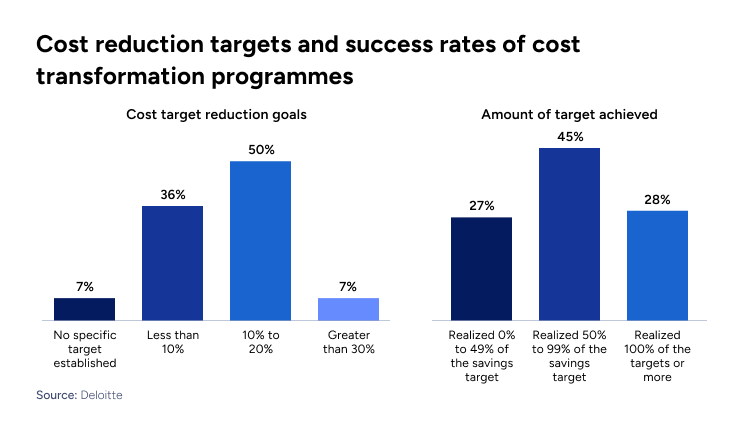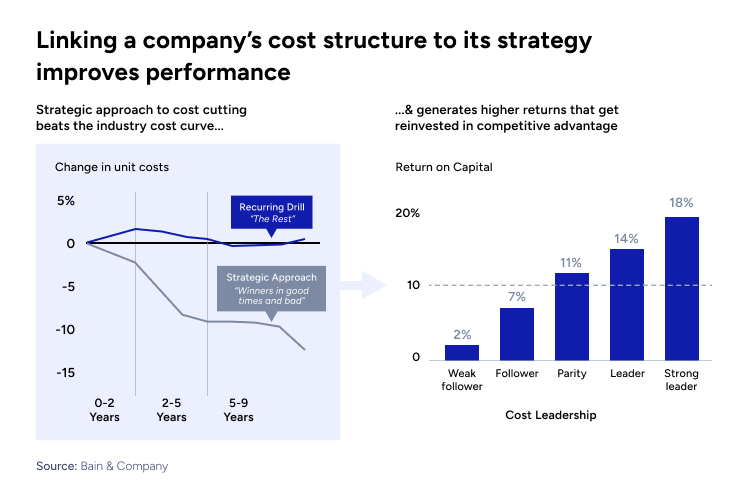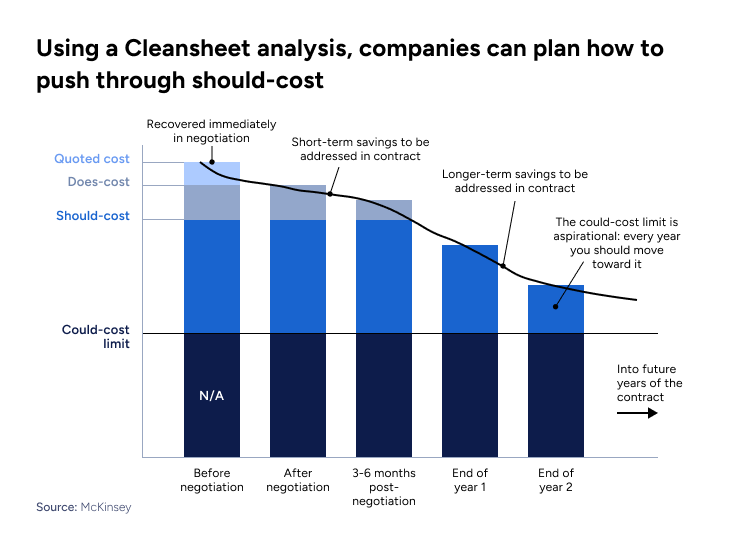How to Drive a Successful Cost Transformation Program



With high inflation rates and slow economic growth anticipated in the next five years, there is an increasing pressure on companies to not only reduce, but also transform their cost structure. A survey by Deloitte found that 72% of organizations failed to meet their cost reduction targets, often due to fragmented strategies and lack of governance. To stay competitive, businesses must move beyond temporary cuts and implement sustainable cost transformation programs.

Cost-cutting measures are highly effective when focused on specific functions like procurement, manufacturing, and operations. At the same time, advanced technologies such as AI, process automation, and real-time analytics have proven to increase efficiency and improve cost control. However, without integrating these efforts into a long-term framework, companies risk cost creep and a return to inefficiency.
Organizations that adopt a comprehensive approach to cost transformation can achieve more than financial savings. They create scalable improvements through rigorous governance, enhanced tools, and reliable data. These efforts also help build stronger teams, improve company culture, and establish better ways of working, ultimately aligning the organization with its strategic goals.
This article will explore how organizations can achieve meaningful cost transformation by answering the following questions:
- How can organizations address common roadblocks to successful cost transformation implementation?
- What are the strategies enabling organizations to reallocate resources for growth effectively?
- How can companies leverage technology to create sustainable cost structures?
The Recipe for an Effective Cost Transformation
Cost transformation begins with a focus on cutting expenses, but the real value lies in the “transformation” aspect. Effective programs are not one-off initiatives but long-term strategies that deliver lasting results. While initial actions may produce quick financial benefits, a successful transformation reimagines all aspects of the business—from operating models and processes to workforce capabilities, supplier relationships, and partnerships.
The Main Factors Driving Success in Cost Transformation Programs
To address internal and external challenges, companies should clearly define how they can achieve a competitive and sustainable cost structure while setting up the right capabilities and technologies to operate and grow efficiently. According to a Deloitte survey, cost transformations succeed when key factors are prioritized and implemented effectively:
- Solid Tracking and Reporting (72%): Real-time tracking mechanisms ensure progress is monitored and adjustments are made promptly.
- Clear Business Case (65%): A well-defined business case aligns stakeholders and sets realistic, measurable goals.
- Effective Change Management (64%): Addressing resistance and fostering a culture of efficiency is vital for long-term success.
- Investment in Technology Improvements (62%): Advanced tools like process mining and intelligent automation help identify inefficiencies and unlock savings.
- Realistic Cost Targets (58%): Practical goals ensure that initiatives are achievable and aligned with the organization’s capabilities.
- Dedicated Leadership (46%): Strong leadership drives accountability, maintains momentum, and aligns initiatives with strategic objectives.
Senior executives acknowledge the need to move beyond small-scale, isolated initiatives and adopt comprehensive transformation strategies that leverage all available options. This includes not only traditional cost-saving measures like procurement and organizational restructuring, but also technology-driven cost levers and analytical tools.
The Role of Technology
Technology significantly enhances cost reduction efforts by delivering data-driven insights and streamlining operations. As per Accenture, Generative AI could automate up to 29% of supply chain activities, achieving up to 13% additional cost savings for early adopters.
However, while 97% of executives recognize AI’s potential to transform their industries, only 31% have significantly invested in AI initiatives. This gap highlights the urgency for companies to implement AI effectively to optimize costs and drive growth. Some benefits of AI implementation include:
- Analyze operations and define the ‘right cost’ structure: Advanced AI and machine learning tools provide granular insights into cost-driving activities. For example, AI can aid SKU rationalization by analyzing product performance, demand, and profitability, and optimizing product portfolios. Benchmarking against internal and external data helps unlock value in the supply chain.
- Drive new ways of working: Employees need consistent tools and insights that offer a unified source of truth across the organization.
- Leverage advanced scenario modeling tools: These tools provide real-time insights into the impact of buying decisions, allowing employees to understand key cost drivers and make better planning and spending decisions. This is crucial for sustained cost structure changes.
Three-Step Approach to Achieve Successful Cost Transformation
A structured approach to cost management can significantly improve the success of a transformation through:
- Ongoing value delivery, ensuring that the gains from the transformation are both realized in the short term and maintained over time.
- Evolving capabilities, equipping the organization with the skills and tools required for continuous improvement.
- Cultural change, aligning the organization with new working methods, and keeping employees engaged in the transformation process.

Step 1: Diagnose and Plan
Understand the Cost Baseline
A successful cost transformation starts with a thorough analysis of cost categories, prioritizing those with the highest potential return on investment. Leaders must evaluate which costs to address first, considering the resources these actions will release to fund strategic goals. Cost-cutting measures are highly effective measures when focused on specific functions like procurement, manufacturing, and operations. For instance, renegotiating supplier contracts has led companies to achieve gross margin improvements of up to 1.6%.
Common starting points include sales, general, and administrative (SG&A) costs, where initiatives may focus on improving account management, incentive structures, and reporting processes to enable growth.
G&A functions such as HR, finance, IT, and legal can benefit from process redesign or automation to eliminate inefficiencies. For example, resetting organizational design can optimize roles, team structures, and performance metrics.
Procurement costs—both direct (raw materials) and indirect (office supplies, travel)—require separate assessments due to their differing nature. Leaders must weigh the implications of changes to direct procurement on product quality and performance.
Additionally, major cost categories like supply chain, manufacturing, and logistics must be reviewed to identify long-term optimization opportunities.
Link Cost Structure to Strategy
Linking a company’s cost structure to its strategy helps companies gain a competitive advantage. Cost reduction should not be approached as an isolated effort but as a process of resource reallocation to reinforce strategic priorities and enhance competitiveness. By systematically identifying and divesting poorly utilized resources, organizations can reallocate them to activities that strengthen their market position or drive growth.
This approach integrates top-down strategic clarity with bottom-up execution, creating cross-functional momentum that goes beyond incremental improvements. It enables cross-functional gains by focusing on areas where cost efficiency can directly support the company’s competitive edge. For example, Bain & Company’s research shows that 40% of cost leaders are also premium product producers, demonstrating that strategic cost alignment can enable reinvestment in innovation and differentiation.
To do so, companies need to establish clear, measurable goals focused on driving long-term cost improvement, incorporate governance mechanisms to track progress, hold teams accountable, and foster a cultural shift.

Step 2: Manage and Execute
Executing a successful cost transformation requires strong leadership, data-driven insights, and a focus on people’s training and management. This step ensures that strategic goals translate into sustainable results.

Leverage Data for Insights and Prioritization
A strong foundation starts with an analysis of current operations and workflows to identify performance gaps that drain value. This process pinpoints inefficiencies and opportunities for automation or digital upgrades. Data-driven insights enable organizations to benchmark performance and define short-, medium-, and long-term goals. By addressing these gaps, companies can “right-size” expenses and ensure resources are allocated effectively to achieve their strategic objectives.
Leadership at All Levels
The CEO and senior leadership must champion the transformation, setting a clear vision and breaking down barriers to success. However, middle-level managers also play a crucial role in day-to-day execution. Their engagement ensures alignment with strategic goals and drives momentum across teams. Motivated managers can inspire their teams, generate innovative cost-saving ideas, and sustain enthusiasm for the program. Incentives aligned with transformation targets foster accountability and collaboration, ensuring the workforce is fully committed.
Balance Technology with the Human Aspect
To integrate technology effectively into cost transformation efforts, it is essential to include the Chief Technology Officer (CTO) in the steering committee to align technology initiatives with organizational goals. However, the human aspect is often the greatest challenge. Technology itself accounts for only 10% of transformation challenges, while 70% stem from managing people. Leaders must prioritize transparent communication to align employees with enterprise-wide goals, especially when standardizing tools or processes across business units.
Celebrate Quick Wins and Monitor Progress
Demonstrating early successes reinforces confidence in the transformation. Quick wins—such as renegotiating contracts or reducing redundant tasks—release immediate savings and motivate employees. Celebrating small victories and tracking their impact fosters trust and engagement, encouraging the organization to stay committed to achieving long-term cost transformation goals.
This phase is particularly important, as pushing through should-cost improvements is a gradual process that requires time and commitment. Significant cost reductions often depend on actions like supplier investments in new equipment or customer efforts to develop alternative sources, which can take years to materialize. In this case, Cleansheet analysis can play a critical role, serving as a transparent, data-driven framework to monitor progress. Breaking costs into segments helps organizations identify immediate opportunities, plan for medium-term adjustments, tackle longer-term inefficiencies, and identify early wins.

Step 3: Sustain and Scale
Achieving long-term cost transformation success requires embedding a continuous cost-efficiency mindset across all levels of the organization. By making cost efficiency a core part of the company’s culture, leaders ensure that savings endure and continue to support strategic goals. Four actions are crucial to maintaining momentum.

1. Drive New Ways of Working
To adapt to evolving market conditions, organizations must leverage advanced analytics and real-time insights, such as Tableau, Power BI, or SAP Analytics Cloud. These tools consolidate data from multiple sources, offering real-time dashboards that visualize trends and anomalies. Providing employees with these tools fosters a culture of informed decision-making and trust, ensuring quick responses to external changes and keeping operations aligned with strategic objectives.
2. Adopt a CEO Mindset
A mindset shift is essential to make cost transformation sustainable. Leadership should move beyond cost-effectiveness and focus on achieving enterprise-wide excellence. Empower teams to think and act like CEOs, encouraging them to own their roles in driving transformation. Delegation, monitoring, and empowerment allow employees to align decisions with the organization’s overarching goals.
3. Align Incentives and Rewards
Tie key performance indicators (KPIs) to executive contracts using metrics such as cost savings achieved, operating margin improvement, or efficiency gains across critical processes. Specific KPIs might include reduction in procurement costs, percentage of processes automated, or adherence to budgetary timelines. These should align with the organization’s strategic goals, ensuring that rewards drive desired behaviors.
The best incentive structure depends on the company’s culture and operational norms. In financially driven organizations, performance-based bonuses tied to cost savings or EBITDA improvement often work best. Recognition programs such as public acknowledgment, leadership development opportunities, or stock options can be equally motivating in mission-driven or collaborative environments.
4. Lead by Example
Leadership teams must consistently demonstrate cost-conscious behavior. Integrate cost management into the budgeting process and make it a standing agenda item at key business reviews. By modeling the desired behaviors, leaders set the tone for the entire organization.
Finally, leaders must remain diligent and patient, monitoring progress and adjusting strategies over time. While the journey is challenging, the benefits—a more competitive, agile organization—justify the effort. A successful program liberates resources, strengthens capabilities, and builds lasting competitive advantage.
Cost Transformation at Consultport
Despite the promising potential of change management initiatives, 70% of transformation programs fail to achieve their goals. Key challenges include employee resistance, inadequate leadership support, and outdated methodologies that fail to leverage modern IT solutions.
Here is where Independent Cost Reduction Consultants can help. They analyze spending, identify inefficiencies, and help renegotiate supplier contracts, streamline procurement processes, or redesign workflows to eliminate unnecessary expenses, at a fraction of the cost of traditional consultancies.
Consulting platforms like Consultport streamline the hiring process by matching businesses with top-tier independent consultants in 48 hours. With a vast pool of pre-vetted experts, Consultport ensures clients find the perfect fit for their needs, saving time and reducing costs.
Want to know more? Find a consultant.
on a weekly basis.

